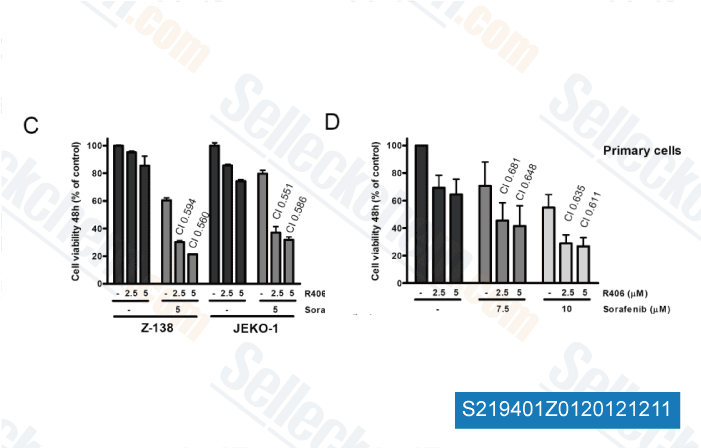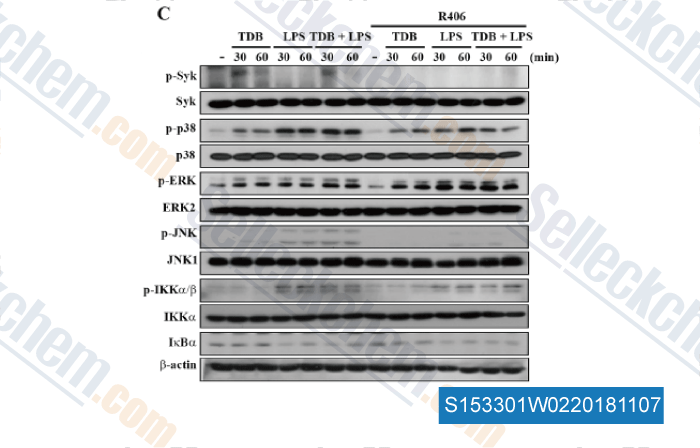|
Toll Free: (877) 796-6397 -- USA and Canada only -- |
Fax: +1-832-582-8590 Orders: +1-832-582-8158 |
Tech Support: +1-832-582-8158 Ext:3 Please provide your Order Number in the email. |
Technical Data
| Formula | C22H23FN6O5 |
||||||
| Molecular Weight | 470.45 | CAS No. | 841290-80-0 | ||||
| Solubility (25°C)* | In vitro | DMSO | 29 mg/mL (61.64 mM) | ||||
| Water | Insoluble | ||||||
| Ethanol | Insoluble | ||||||
| In vivo (Add solvents to the product individually and in order) |
|
||||||
|
* <1 mg/ml means slightly soluble or insoluble. * Please note that Selleck tests the solubility of all compounds in-house, and the actual solubility may differ slightly from published values. This is normal and is due to slight batch-to-batch variations. * Room temperature shipping (Stability testing shows this product can be shipped without any cooling measures.) |
|||||||
Preparing Stock Solutions
Biological Activity
| Description | R406 (free base) is a potent Syk inhibitor with IC50 of 41 nM in a cell-free assay, strongly inhibits Syk but not Lyn, 5-fold less potent to Flt3. This compound triggers apoptosis. Phase 1. | ||||
|---|---|---|---|---|---|
| Targets |
|
||||
| In vitro | R406 (free base) is an ATP-competitive inhibitor of Syk with a Ki value of 30 nM. This compound selectively inhibits Syk-dependent signaling with EC50 values ranging from 33 nM to 171 nM, more potently than Syk-independent pathways in different cells. [1] It inhibits cellular proliferation of a large panel of diffuse large B-cell lymphoma (DLBCL) cell lines at EC50 values ranging from 0.8 μM to 8.1 μM. This chemical treatment (1 μM or 4 μM) induces the activation of caspases 9 and 3, but not caspase 8, leading to significant apoptosis of the majority of DLBCL cell lines. Pretreatment of this compound completely blocks the phosphorylation of SYK525/526 and the SYK-dependent phosphorylation of BLNK in R406-sensitive DLBCLs following B-cell receptor (BCR) crosslinking. [2] It potently decreases MMP-9 mRNA levels by 2.8- and 4.3-fold lower than controls after 24 and 48 hours treatment, respectively, and reduces the invasive capacity of the RL cells. [3] | ||||
| In vivo | R406 (free base) has shown efficacy in a number of animal models of immune disorders. Oral administration of this compound in mice with immune complex-mediated inflammation significantly inhibits the cutaneous reverse passive Arthus reaction by approximately 72% and 86% at 1 mg/kg and 5 mg/kg, respectively, compared with the control. This compound treatment at 10 mg/kg significantly reduces inflammation and swelling, decreases the progressive arthritis to a lower level in the passive anticollagen antibody-challenged mice, and delays the onset and reduces paw thickening and clinical arthritis by approximately 50% in the K/BxN serum transfer mice model. [1] |
Protocol (from reference)
| Kinase Assay: |
|
|---|---|
| Cell Assay: |
|
| Animal Study: |
|
References
|
Customer Product Validation

-
Data from [ Clin Cancer Res , 2013 , 19(3), 586-597 ]

-
Data from [ , , Mol Neurobiol, 2018, doi: 10.1007/s12035-018-1135-4 ]
Selleck's R406 (free base) Has Been Cited by 109 Publications
| R406 and its structural analogs reduce SNCA/α-synuclein levels via autophagic degradation [ Autophagy, 2025, 1-17.] | PubMed: 40143425 |
| TLR4 endocytosis and endosomal TLR4 signaling are distinct and independent outcomes of TLR4 activation [ EMBO Rep, 2025, 10.1038/s44319-025-00444-2] | PubMed: 40204912 |
| Hypoxia promotes metastasis by relieving miR-598-3p-restricted glycolysis in gastric cancer [ J Transl Med, 2024, 22(1):283] | PubMed: 38491378 |
| DNA hypomethylation of Syk induces oxidative stress and apoptosis via the PKCβ/P66shc signaling pathway in diabetic kidney disease [ FASEB J, 2024, 38(6):e23564] | PubMed: 38522019 |
| Loss of NF1 in Melanoma Confers Sensitivity to SYK Kinase Inhibition [ Cancer Res, 2023, 83(2):316-331] | PubMed: 36409827 |
| Identification of new drugs to counteract anti-spike IgG-induced hyperinflammation in severe COVID-19 [ Life Sci Alliance, 2023, 6(11)e202302106] | PubMed: 37699657 |
| Identification of new drugs to counteract anti-spike IgG-induced hyperinflammation in severe COVID-19 [ Life Sci Alliance, 2023, 6(11)e202302106] | PubMed: 37699657 |
| Interleukin 33-mediated inhibition of A-type K+ channels induces sensory neuronal hyperexcitability and nociceptive behaviors in mice [ Theranostics, 2022, 12(5):2232-2247] | PubMed: 35265208 |
| B-cell antigen receptor expression and phosphatidylinositol 3-kinase signaling regulate genesis and maintenance of mouse chronic lymphocytic leukemia [ Haematologica, 2022, 107(8):1796-1814] | PubMed: 35021605 |
| Polyaniline-Based Glyco-Condensation on Au Nanoparticles Enhances Immunotherapy in Lung Cancer [ ACS Appl Mater Interfaces, 2022, 14(21):24144-24159] | PubMed: 35579575 |
RETURN POLICY
Selleck Chemical’s Unconditional Return Policy ensures a smooth online shopping experience for our customers. If you are in any way unsatisfied with your purchase, you may return any item(s) within 7 days of receiving it. In the event of product quality issues, either protocol related or product related problems, you may return any item(s) within 365 days from the original purchase date. Please follow the instructions below when returning products.
SHIPPING AND STORAGE
Selleck products are transported at room temperature. If you receive the product at room temperature, please rest assured, the Selleck Quality Inspection Department has conducted experiments to verify that the normal temperature placement of one month will not affect the biological activity of powder products. After collecting, please store the product according to the requirements described in the datasheet. Most Selleck products are stable under the recommended conditions.
NOT FOR HUMAN, VETERINARY DIAGNOSTIC OR THERAPEUTIC USE.
